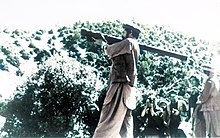Operation Cyclone

Operation Cyclone (English for Zyklon ) was the cover name for an enterprise of the US-American foreign intelligence service CIA during the Cold War , which from summer 1979 in close cooperation with the Pakistani secret service ISI dealt with the arming, training and financing of Islamist Afghan resistance fighters ( mujahideen ) . The first aim was the overthrow of after the Saur Revolution called coup of 1978 resulting pro -Soviet Democratic Republic of Afghanistan , and from the beginning of the Soviet military intervention in December 1979, forcing the withdrawal of the invading forces.
course
On July 3, 1979, at the suggestion of his security advisor Zbigniew Brzeziński , US President Jimmy Carter signed the first directive in support of anti-communist Afghan mujahideen with u. a. 500,000 USD for propaganda material, radios and medical care. In the spring of 1979 around 5,000 civil and military Soviet advisers had already gathered in the country, and they were increasingly the target of attacks by opposition fighters during the Afghan civil war . In January 1980, after the Soviet invasion, Carter approved direct arming of the mujahideen in Afghanistan. For the purpose of secrecy, with the knowledge of the supervisory bodies in Congress, Soviet weapons were bought in third countries such as China and Egypt and delivered to Afghanistan via Pakistan. According to later statements by Brzeziński, the US authorities also bought Soviet weapons from the Czechoslovak government and even directly from corrupt units of the Soviet army in Afghanistan.
Under the presidency of Ronald Reagan from 1981, the activities in the context of Operation Cyclone were greatly intensified. The arms shipments now also included anti-aircraft guns from US production as the FIM-92 Stinger .
Operation Cyclone was one of the longest and most expensive CIA operations ever. In total, around two billion US dollars, and according to other sources even more than six billion US dollars, were sent to Pakistan from the USA. The funds made available by the US Congress were concealed in the budget, and the Democratic MP in the House of Representatives, Charlie Wilson , is considered to be the main motor for increasing the funding of the operation . The Saudi Arabian government, in coordination with the United States, provided the operation with the same amount of financial assistance.
criticism
The support of the mujahideen led to a strengthening of Islamism in Afghanistan, which paved the way for the Taliban and al-Qaeda . Among the Islamic fundamentalists sponsored by Operation Cyclone was Gulbuddin Hekmatyār , a later supporter of Osama bin Laden . Support and training from bin Laden himself and from Abdurajik Abubakar Janjalani , founder of the Philippine terrorist organization Abu Sajaf , has been described by some authors. From the end of 2001 these Islamist groups in Afghanistan were fought by the USA and pushed underground.
Web links
- L. Britt Snider: The Agency & The Hill: CIA's Relationship with Congress, 1946-2004 (PDF, 3.5 MB), CIA, Washington 2008, especially Chapter 9: Oversight of Covert Action (English)
See also
- Reagan Doctrine
- War in Afghanistan
- Mujahideen in Afghanistan
- Fred Iklé
- Charlie Wilson's War - Adaptation with Tom Hanks on the role of MP Wilson in this operation
- Was on terror
Individual evidence
-
↑ Steve Coll: Ghost Wars. The Secret History of the CIA, Afghanistan, and bin Laden, from the Soviet Invasion to September 10, 2001. Penguin Books, New York 2005, ISBN 978-0-14-303466-7 , pp. 46 (English, limited preview in Google Book Search). Robert M. Gates: From the Shadows. The Ultimate Insider's Story of Five Presidents and How They Won the Cold War. Simon & Schuster, New York 1996, ISBN 0-684-81081-6 , pp.
146 (English, limited preview in Google Book search). - ↑ Uwe Klußmann: The Triumph of the West: Brave, tough people, in: Spiegel Special Geschichte from July 29, 2008, accessed on September 30, 2014
- ^ A b L. Britt Snider: The Agency & The Hill - CIA's Relationship with Congress, 1946-2004 . 2008, p. 284 ( cia.gov [PDF]).
- ↑ Interview with Dr Zbigniew Brzezinski, June 13, 1997, on the National Security Archive website , accessed on September 30, 2014 (English)
- ↑ Ursula Lehmkuhl: The Reagan Years: Back to the "old glory". In: Dossier USA. Federal Agency for Political Education, October 11, 2008, archived from the original on September 30, 2014 ; accessed on September 30, 2014 .
- ↑ a b Hasnain Kazim: 30 Years of the Afghanistan Invasion: The Soviet Waterloo, in: Spiegel Online of December 22, 2009, accessed on September 30, 2014
- ↑ Cold War: Files prove Western aid for Islamists in Afghanistan, in: Zeit Online of December 30, 2010, accessed on September 30, 2014
- ↑ Steve Coll: Ghost Wars. The Secret History of the CIA, Afghanistan, and bin Laden, from the Soviet Invasion to September 10, 2001. Penguin Books, New York 2005, ISBN 978-0-14-303466-7 , pp. 131 .
- ↑ Al-Qaeda's origins and links. BBC, July 20, 2004, accessed May 27, 2020 .
- ^ Robin Cook: The struggle against terrorism cannot be won by military means. The Guardian, July 8, 2005, accessed May 27, 2020 .
- ↑ Armin Wertz: The world rulers: Military and secret service operations of the USA. Westend, Frankfurt am Main 2015 ISBN 9783864890888
- ↑ Al-Qaeda's origins and links , "The organization grew out of the network of Arab volunteers who had gone to Afghanistan in the 1980s to fight under the banner of Islam against Soviet Communism." BBC News, July 20, 2004, accessed November 30, 2018